Accounting Ratios
VerifiedAdded on 2023/01/11
|8
|1935
|48
AI Summary
Please find attached Assignment Brief and Assignment structure Review Task 2 only
Contribute Materials
Your contribution can guide someone’s learning journey. Share your
documents today.

Accounting Ratios
Secure Best Marks with AI Grader
Need help grading? Try our AI Grader for instant feedback on your assignments.
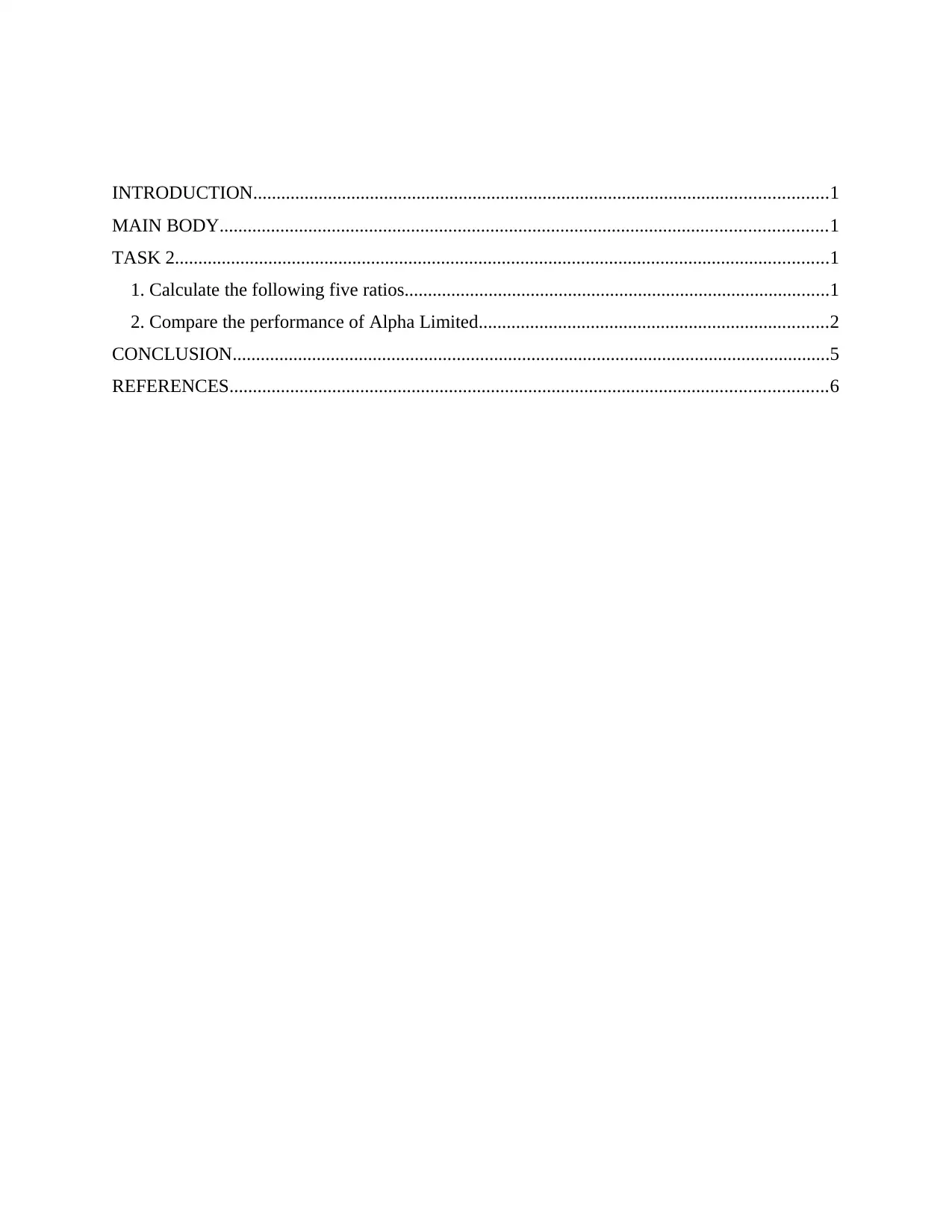
INTRODUCTION...........................................................................................................................1
MAIN BODY..................................................................................................................................1
TASK 2............................................................................................................................................1
1. Calculate the following five ratios...........................................................................................1
2. Compare the performance of Alpha Limited...........................................................................2
CONCLUSION................................................................................................................................5
REFERENCES................................................................................................................................6
MAIN BODY..................................................................................................................................1
TASK 2............................................................................................................................................1
1. Calculate the following five ratios...........................................................................................1
2. Compare the performance of Alpha Limited...........................................................................2
CONCLUSION................................................................................................................................5
REFERENCES................................................................................................................................6
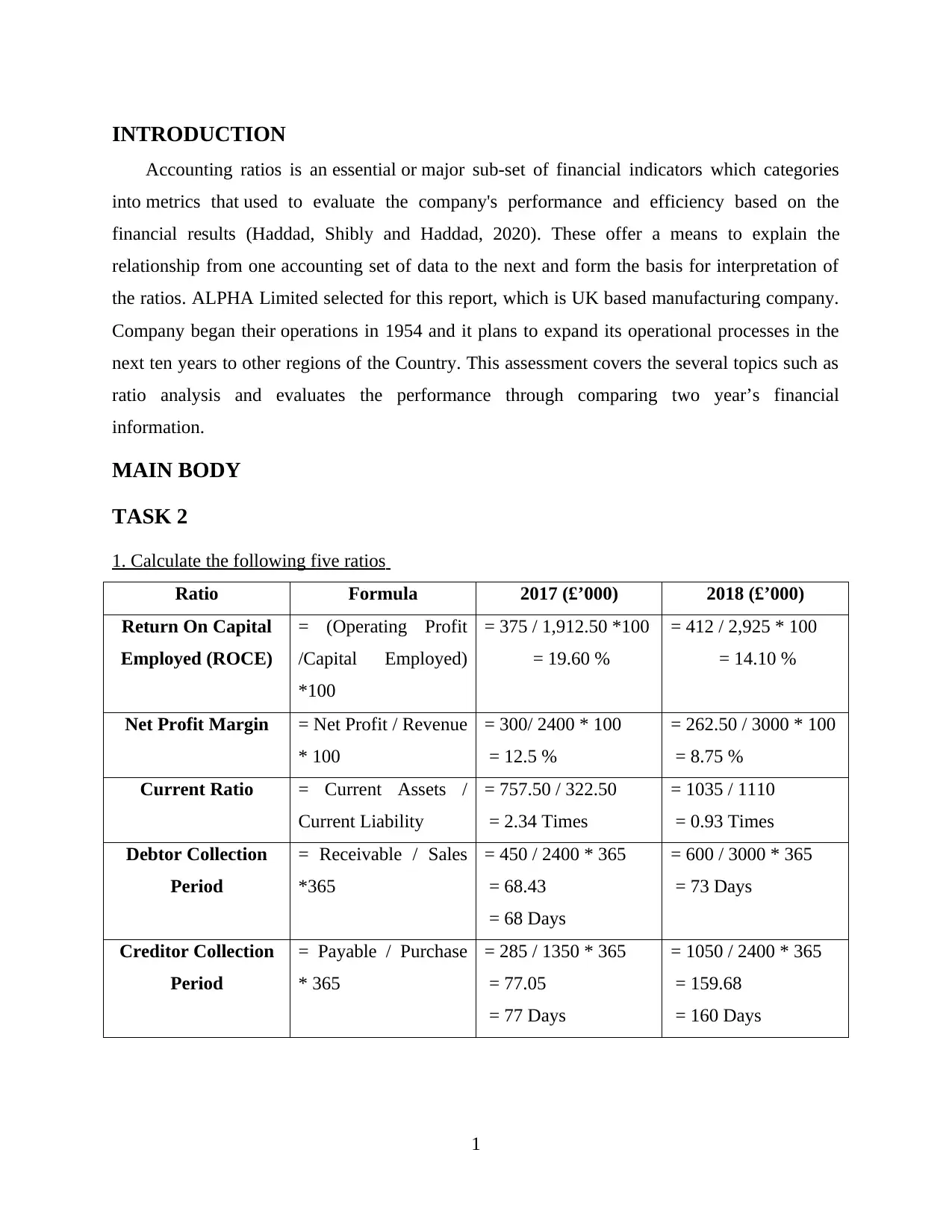
INTRODUCTION
Accounting ratios is an essential or major sub-set of financial indicators which categories
into metrics that used to evaluate the company's performance and efficiency based on the
financial results (Haddad, Shibly and Haddad, 2020). These offer a means to explain the
relationship from one accounting set of data to the next and form the basis for interpretation of
the ratios. ALPHA Limited selected for this report, which is UK based manufacturing company.
Company began their operations in 1954 and it plans to expand its operational processes in the
next ten years to other regions of the Country. This assessment covers the several topics such as
ratio analysis and evaluates the performance through comparing two year’s financial
information.
MAIN BODY
TASK 2
1. Calculate the following five ratios
Ratio Formula 2017 (£’000) 2018 (£’000)
Return On Capital
Employed (ROCE)
= (Operating Profit
/Capital Employed)
*100
= 375 / 1,912.50 *100
= 19.60 %
= 412 / 2,925 * 100
= 14.10 %
Net Profit Margin = Net Profit / Revenue
* 100
= 300/ 2400 * 100
= 12.5 %
= 262.50 / 3000 * 100
= 8.75 %
Current Ratio = Current Assets /
Current Liability
= 757.50 / 322.50
= 2.34 Times
= 1035 / 1110
= 0.93 Times
Debtor Collection
Period
= Receivable / Sales
*365
= 450 / 2400 * 365
= 68.43
= 68 Days
= 600 / 3000 * 365
= 73 Days
Creditor Collection
Period
= Payable / Purchase
* 365
= 285 / 1350 * 365
= 77.05
= 77 Days
= 1050 / 2400 * 365
= 159.68
= 160 Days
1
Accounting ratios is an essential or major sub-set of financial indicators which categories
into metrics that used to evaluate the company's performance and efficiency based on the
financial results (Haddad, Shibly and Haddad, 2020). These offer a means to explain the
relationship from one accounting set of data to the next and form the basis for interpretation of
the ratios. ALPHA Limited selected for this report, which is UK based manufacturing company.
Company began their operations in 1954 and it plans to expand its operational processes in the
next ten years to other regions of the Country. This assessment covers the several topics such as
ratio analysis and evaluates the performance through comparing two year’s financial
information.
MAIN BODY
TASK 2
1. Calculate the following five ratios
Ratio Formula 2017 (£’000) 2018 (£’000)
Return On Capital
Employed (ROCE)
= (Operating Profit
/Capital Employed)
*100
= 375 / 1,912.50 *100
= 19.60 %
= 412 / 2,925 * 100
= 14.10 %
Net Profit Margin = Net Profit / Revenue
* 100
= 300/ 2400 * 100
= 12.5 %
= 262.50 / 3000 * 100
= 8.75 %
Current Ratio = Current Assets /
Current Liability
= 757.50 / 322.50
= 2.34 Times
= 1035 / 1110
= 0.93 Times
Debtor Collection
Period
= Receivable / Sales
*365
= 450 / 2400 * 365
= 68.43
= 68 Days
= 600 / 3000 * 365
= 73 Days
Creditor Collection
Period
= Payable / Purchase
* 365
= 285 / 1350 * 365
= 77.05
= 77 Days
= 1050 / 2400 * 365
= 159.68
= 160 Days
1
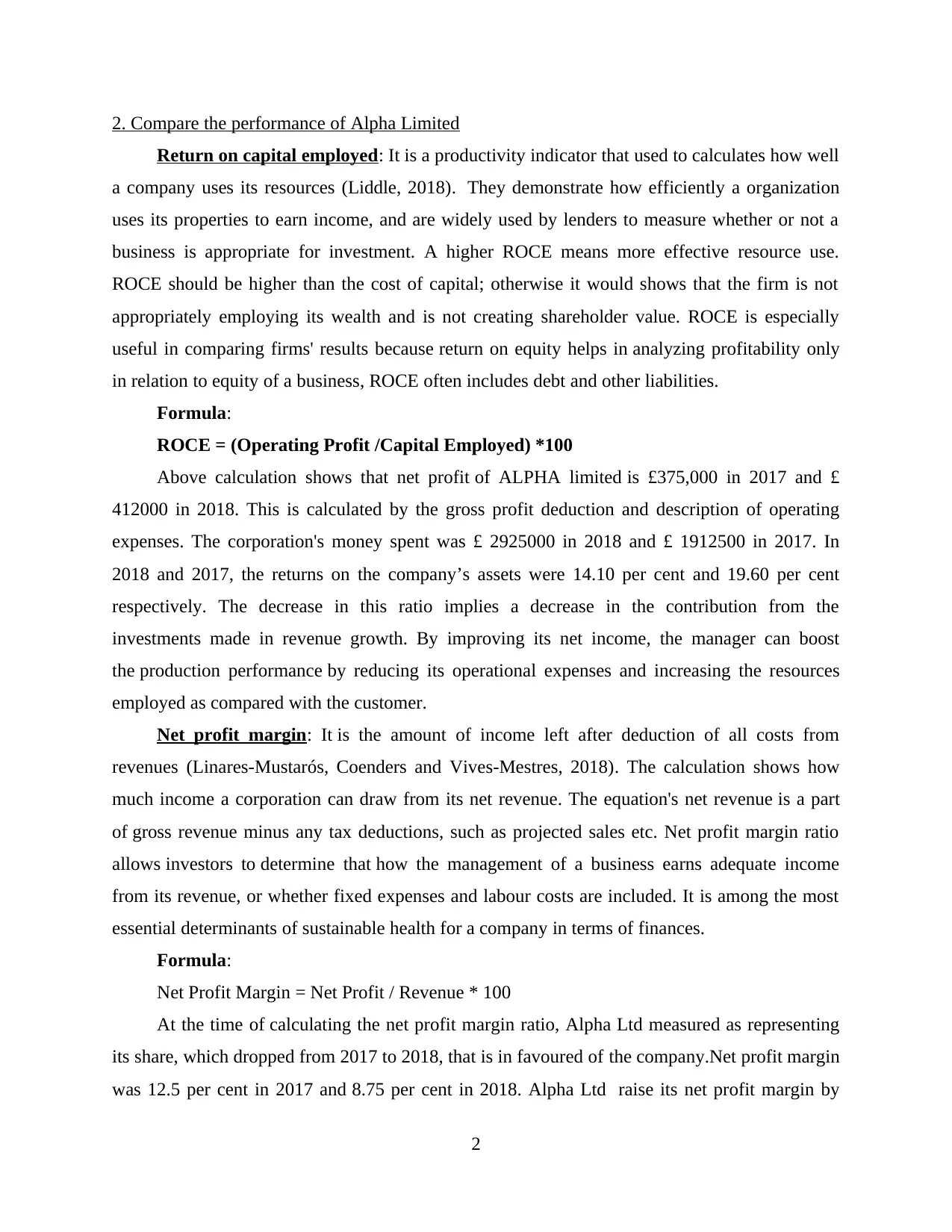
2. Compare the performance of Alpha Limited
Return on capital employed: It is a productivity indicator that used to calculates how well
a company uses its resources (Liddle, 2018). They demonstrate how efficiently a organization
uses its properties to earn income, and are widely used by lenders to measure whether or not a
business is appropriate for investment. A higher ROCE means more effective resource use.
ROCE should be higher than the cost of capital; otherwise it would shows that the firm is not
appropriately employing its wealth and is not creating shareholder value. ROCE is especially
useful in comparing firms' results because return on equity helps in analyzing profitability only
in relation to equity of a business, ROCE often includes debt and other liabilities.
Formula:
ROCE = (Operating Profit /Capital Employed) *100
Above calculation shows that net profit of ALPHA limited is £375,000 in 2017 and £
412000 in 2018. This is calculated by the gross profit deduction and description of operating
expenses. The corporation's money spent was £ 2925000 in 2018 and £ 1912500 in 2017. In
2018 and 2017, the returns on the company’s assets were 14.10 per cent and 19.60 per cent
respectively. The decrease in this ratio implies a decrease in the contribution from the
investments made in revenue growth. By improving its net income, the manager can boost
the production performance by reducing its operational expenses and increasing the resources
employed as compared with the customer.
Net profit margin: It is the amount of income left after deduction of all costs from
revenues (Linares-Mustarós, Coenders and Vives-Mestres, 2018). The calculation shows how
much income a corporation can draw from its net revenue. The equation's net revenue is a part
of gross revenue minus any tax deductions, such as projected sales etc. Net profit margin ratio
allows investors to determine that how the management of a business earns adequate income
from its revenue, or whether fixed expenses and labour costs are included. It is among the most
essential determinants of sustainable health for a company in terms of finances.
Formula:
Net Profit Margin = Net Profit / Revenue * 100
At the time of calculating the net profit margin ratio, Alpha Ltd measured as representing
its share, which dropped from 2017 to 2018, that is in favoured of the company.Net profit margin
was 12.5 per cent in 2017 and 8.75 per cent in 2018. Alpha Ltd raise its net profit margin by
2
Return on capital employed: It is a productivity indicator that used to calculates how well
a company uses its resources (Liddle, 2018). They demonstrate how efficiently a organization
uses its properties to earn income, and are widely used by lenders to measure whether or not a
business is appropriate for investment. A higher ROCE means more effective resource use.
ROCE should be higher than the cost of capital; otherwise it would shows that the firm is not
appropriately employing its wealth and is not creating shareholder value. ROCE is especially
useful in comparing firms' results because return on equity helps in analyzing profitability only
in relation to equity of a business, ROCE often includes debt and other liabilities.
Formula:
ROCE = (Operating Profit /Capital Employed) *100
Above calculation shows that net profit of ALPHA limited is £375,000 in 2017 and £
412000 in 2018. This is calculated by the gross profit deduction and description of operating
expenses. The corporation's money spent was £ 2925000 in 2018 and £ 1912500 in 2017. In
2018 and 2017, the returns on the company’s assets were 14.10 per cent and 19.60 per cent
respectively. The decrease in this ratio implies a decrease in the contribution from the
investments made in revenue growth. By improving its net income, the manager can boost
the production performance by reducing its operational expenses and increasing the resources
employed as compared with the customer.
Net profit margin: It is the amount of income left after deduction of all costs from
revenues (Linares-Mustarós, Coenders and Vives-Mestres, 2018). The calculation shows how
much income a corporation can draw from its net revenue. The equation's net revenue is a part
of gross revenue minus any tax deductions, such as projected sales etc. Net profit margin ratio
allows investors to determine that how the management of a business earns adequate income
from its revenue, or whether fixed expenses and labour costs are included. It is among the most
essential determinants of sustainable health for a company in terms of finances.
Formula:
Net Profit Margin = Net Profit / Revenue * 100
At the time of calculating the net profit margin ratio, Alpha Ltd measured as representing
its share, which dropped from 2017 to 2018, that is in favoured of the company.Net profit margin
was 12.5 per cent in 2017 and 8.75 per cent in 2018. Alpha Ltd raise its net profit margin by
2
Secure Best Marks with AI Grader
Need help grading? Try our AI Grader for instant feedback on your assignments.
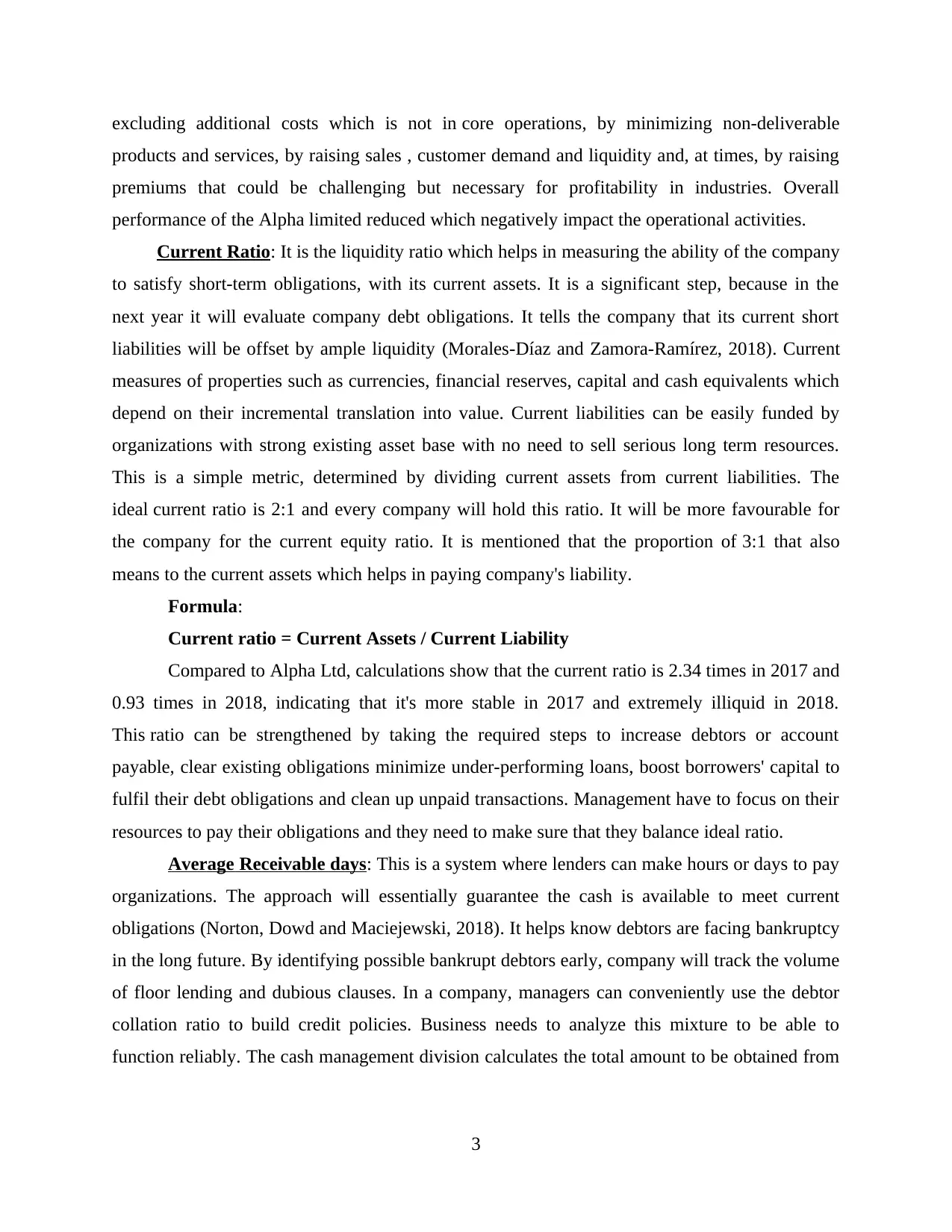
excluding additional costs which is not in core operations, by minimizing non-deliverable
products and services, by raising sales , customer demand and liquidity and, at times, by raising
premiums that could be challenging but necessary for profitability in industries. Overall
performance of the Alpha limited reduced which negatively impact the operational activities.
Current Ratio: It is the liquidity ratio which helps in measuring the ability of the company
to satisfy short-term obligations, with its current assets. It is a significant step, because in the
next year it will evaluate company debt obligations. It tells the company that its current short
liabilities will be offset by ample liquidity (Morales-Díaz and Zamora-Ramírez, 2018). Current
measures of properties such as currencies, financial reserves, capital and cash equivalents which
depend on their incremental translation into value. Current liabilities can be easily funded by
organizations with strong existing asset base with no need to sell serious long term resources.
This is a simple metric, determined by dividing current assets from current liabilities. The
ideal current ratio is 2:1 and every company will hold this ratio. It will be more favourable for
the company for the current equity ratio. It is mentioned that the proportion of 3:1 that also
means to the current assets which helps in paying company's liability.
Formula:
Current ratio = Current Assets / Current Liability
Compared to Alpha Ltd, calculations show that the current ratio is 2.34 times in 2017 and
0.93 times in 2018, indicating that it's more stable in 2017 and extremely illiquid in 2018.
This ratio can be strengthened by taking the required steps to increase debtors or account
payable, clear existing obligations minimize under-performing loans, boost borrowers' capital to
fulfil their debt obligations and clean up unpaid transactions. Management have to focus on their
resources to pay their obligations and they need to make sure that they balance ideal ratio.
Average Receivable days: This is a system where lenders can make hours or days to pay
organizations. The approach will essentially guarantee the cash is available to meet current
obligations (Norton, Dowd and Maciejewski, 2018). It helps know debtors are facing bankruptcy
in the long future. By identifying possible bankrupt debtors early, company will track the volume
of floor lending and dubious clauses. In a company, managers can conveniently use the debtor
collation ratio to build credit policies. Business needs to analyze this mixture to be able to
function reliably. The cash management division calculates the total amount to be obtained from
3
products and services, by raising sales , customer demand and liquidity and, at times, by raising
premiums that could be challenging but necessary for profitability in industries. Overall
performance of the Alpha limited reduced which negatively impact the operational activities.
Current Ratio: It is the liquidity ratio which helps in measuring the ability of the company
to satisfy short-term obligations, with its current assets. It is a significant step, because in the
next year it will evaluate company debt obligations. It tells the company that its current short
liabilities will be offset by ample liquidity (Morales-Díaz and Zamora-Ramírez, 2018). Current
measures of properties such as currencies, financial reserves, capital and cash equivalents which
depend on their incremental translation into value. Current liabilities can be easily funded by
organizations with strong existing asset base with no need to sell serious long term resources.
This is a simple metric, determined by dividing current assets from current liabilities. The
ideal current ratio is 2:1 and every company will hold this ratio. It will be more favourable for
the company for the current equity ratio. It is mentioned that the proportion of 3:1 that also
means to the current assets which helps in paying company's liability.
Formula:
Current ratio = Current Assets / Current Liability
Compared to Alpha Ltd, calculations show that the current ratio is 2.34 times in 2017 and
0.93 times in 2018, indicating that it's more stable in 2017 and extremely illiquid in 2018.
This ratio can be strengthened by taking the required steps to increase debtors or account
payable, clear existing obligations minimize under-performing loans, boost borrowers' capital to
fulfil their debt obligations and clean up unpaid transactions. Management have to focus on their
resources to pay their obligations and they need to make sure that they balance ideal ratio.
Average Receivable days: This is a system where lenders can make hours or days to pay
organizations. The approach will essentially guarantee the cash is available to meet current
obligations (Norton, Dowd and Maciejewski, 2018). It helps know debtors are facing bankruptcy
in the long future. By identifying possible bankrupt debtors early, company will track the volume
of floor lending and dubious clauses. In a company, managers can conveniently use the debtor
collation ratio to build credit policies. Business needs to analyze this mixture to be able to
function reliably. The cash management division calculates the total amount to be obtained from
3

the receivable company accounts or the debtor's balance. Total volume obtained is multiplied
by number of days to deliver results.
Formula:
Account receivable days = Receivable / Sales *365
From the above calculation Alpha Ltd was classified as having accounts receivables of
£450000 in 2017 and £600000 in 2018. The net sales are 24,00,000 in 2017 and 30,000,000 in
2018; then it reports the total profit figure as credit income. The cumulative reporting period for
Alpha Ltd in 2018 is 73 days, and 2017 is 68 days. A reduction in the average turnaround period
is reported here, pointing out that Alpha Ltd 's productivity needed to recover amounts from its
borrowers has deteriorated and the business may face inadequate liquid cash to conduct its
activities in the immediate future. Through rising credit transactions and maximizing the loan
term offered to its lenders then the business will increase this ratio.
Average Payable days:
The Company decides the total amount of money paid out to the borrowers and accounts
payable. Here lenders include retailers, suppliers as well as other short-term funding outlets. The
margin is measured on a monthly or yearly basis and shows how the company conducts its
money outflows (Restianti and Agustina, 2018). It would take the Company some time to pay its
numerous debts with higher creditors. It shows the company's financial potential, which suggests
that productivity is diminished or shareholders are unable to pay. Investors performing this
process also influenced the term credit.
From the calculation of Alpha Ltd accounts payables in 2017 and 2018 is expected to be
£285000 and £1050000 accordingly. Purchase by the business for the periods 2018 and 2017
were £2400000 and £1350000 separately. It's suspected both sales were on credit here. The
cumulative payable duration for the company is 160 days in 2018, and it was 77 days in 2017.
There is an increase reported over the overall payable duration which demonstrates the ability of
the organization to make purchases to its particular payable customers.
Results from the research of Alpha Ltd’s performances, it is decided that investors will not
interested in this company because the average output falls during 2017 to 2018. ROCE, net
profit or current ratio are all are in losses and because of that, investors not ready to invest and
it reduces its production during the year.
4
by number of days to deliver results.
Formula:
Account receivable days = Receivable / Sales *365
From the above calculation Alpha Ltd was classified as having accounts receivables of
£450000 in 2017 and £600000 in 2018. The net sales are 24,00,000 in 2017 and 30,000,000 in
2018; then it reports the total profit figure as credit income. The cumulative reporting period for
Alpha Ltd in 2018 is 73 days, and 2017 is 68 days. A reduction in the average turnaround period
is reported here, pointing out that Alpha Ltd 's productivity needed to recover amounts from its
borrowers has deteriorated and the business may face inadequate liquid cash to conduct its
activities in the immediate future. Through rising credit transactions and maximizing the loan
term offered to its lenders then the business will increase this ratio.
Average Payable days:
The Company decides the total amount of money paid out to the borrowers and accounts
payable. Here lenders include retailers, suppliers as well as other short-term funding outlets. The
margin is measured on a monthly or yearly basis and shows how the company conducts its
money outflows (Restianti and Agustina, 2018). It would take the Company some time to pay its
numerous debts with higher creditors. It shows the company's financial potential, which suggests
that productivity is diminished or shareholders are unable to pay. Investors performing this
process also influenced the term credit.
From the calculation of Alpha Ltd accounts payables in 2017 and 2018 is expected to be
£285000 and £1050000 accordingly. Purchase by the business for the periods 2018 and 2017
were £2400000 and £1350000 separately. It's suspected both sales were on credit here. The
cumulative payable duration for the company is 160 days in 2018, and it was 77 days in 2017.
There is an increase reported over the overall payable duration which demonstrates the ability of
the organization to make purchases to its particular payable customers.
Results from the research of Alpha Ltd’s performances, it is decided that investors will not
interested in this company because the average output falls during 2017 to 2018. ROCE, net
profit or current ratio are all are in losses and because of that, investors not ready to invest and
it reduces its production during the year.
4
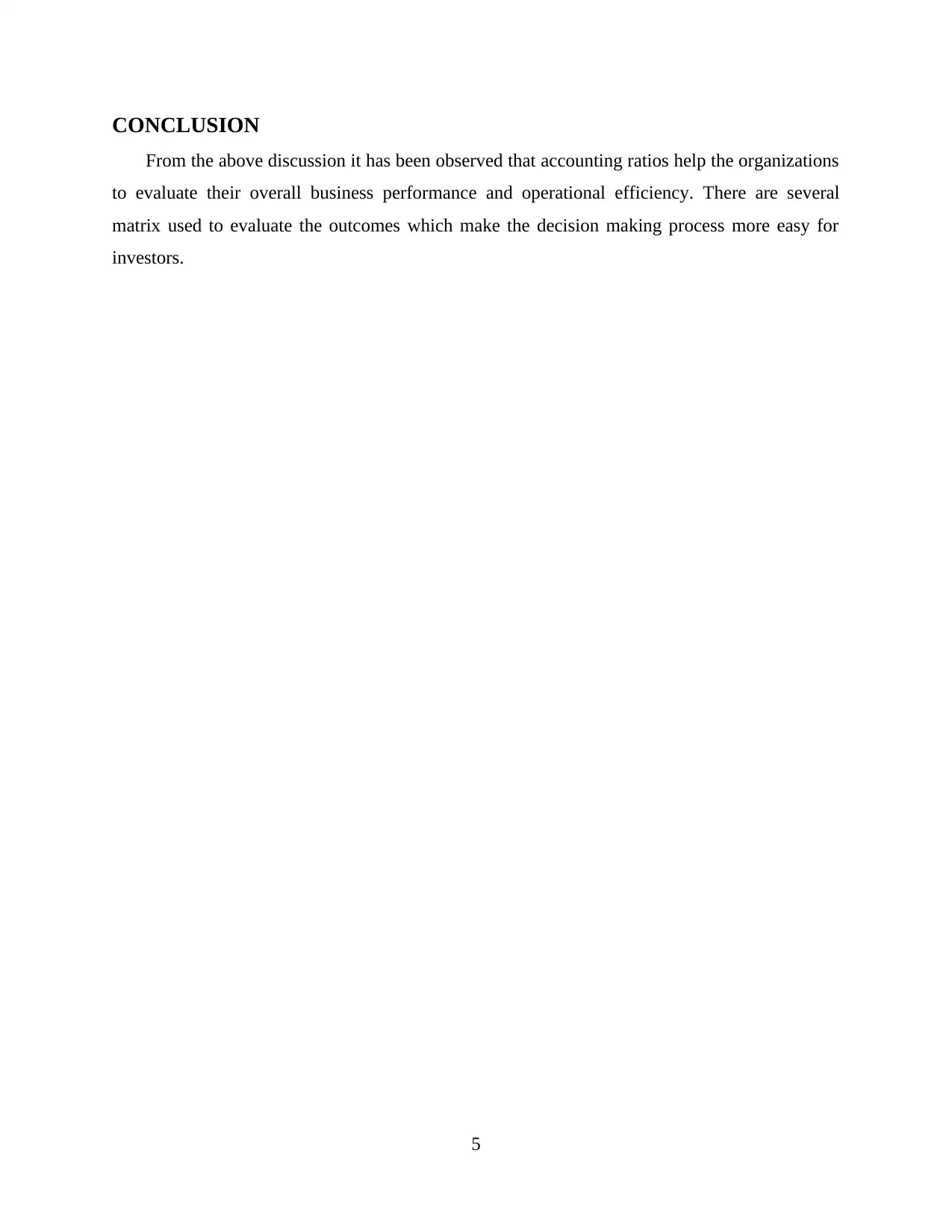
CONCLUSION
From the above discussion it has been observed that accounting ratios help the organizations
to evaluate their overall business performance and operational efficiency. There are several
matrix used to evaluate the outcomes which make the decision making process more easy for
investors.
5
From the above discussion it has been observed that accounting ratios help the organizations
to evaluate their overall business performance and operational efficiency. There are several
matrix used to evaluate the outcomes which make the decision making process more easy for
investors.
5
Paraphrase This Document
Need a fresh take? Get an instant paraphrase of this document with our AI Paraphraser
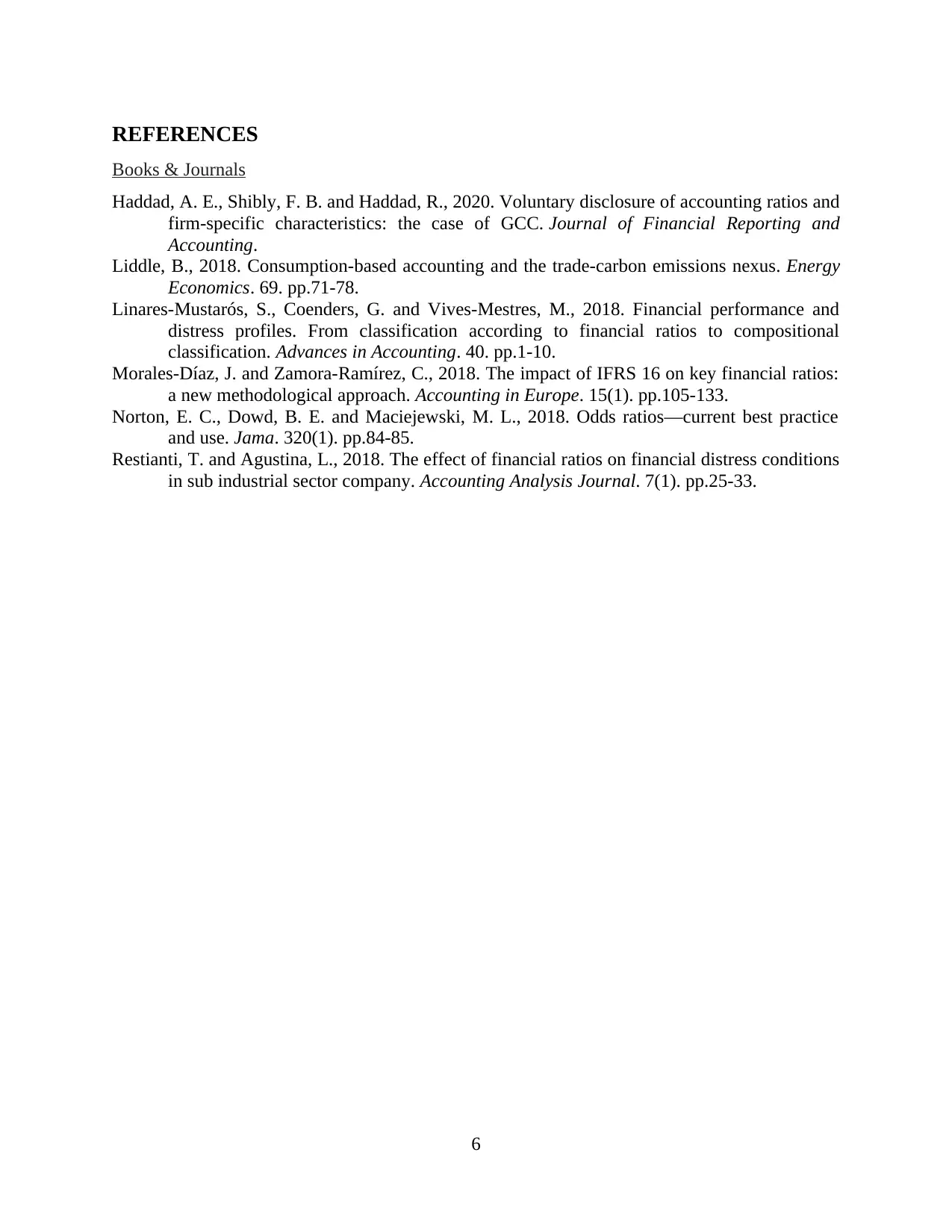
REFERENCES
Books & Journals
Haddad, A. E., Shibly, F. B. and Haddad, R., 2020. Voluntary disclosure of accounting ratios and
firm-specific characteristics: the case of GCC. Journal of Financial Reporting and
Accounting.
Liddle, B., 2018. Consumption-based accounting and the trade-carbon emissions nexus. Energy
Economics. 69. pp.71-78.
Linares-Mustarós, S., Coenders, G. and Vives-Mestres, M., 2018. Financial performance and
distress profiles. From classification according to financial ratios to compositional
classification. Advances in Accounting. 40. pp.1-10.
Morales-Díaz, J. and Zamora-Ramírez, C., 2018. The impact of IFRS 16 on key financial ratios:
a new methodological approach. Accounting in Europe. 15(1). pp.105-133.
Norton, E. C., Dowd, B. E. and Maciejewski, M. L., 2018. Odds ratios—current best practice
and use. Jama. 320(1). pp.84-85.
Restianti, T. and Agustina, L., 2018. The effect of financial ratios on financial distress conditions
in sub industrial sector company. Accounting Analysis Journal. 7(1). pp.25-33.
6
Books & Journals
Haddad, A. E., Shibly, F. B. and Haddad, R., 2020. Voluntary disclosure of accounting ratios and
firm-specific characteristics: the case of GCC. Journal of Financial Reporting and
Accounting.
Liddle, B., 2018. Consumption-based accounting and the trade-carbon emissions nexus. Energy
Economics. 69. pp.71-78.
Linares-Mustarós, S., Coenders, G. and Vives-Mestres, M., 2018. Financial performance and
distress profiles. From classification according to financial ratios to compositional
classification. Advances in Accounting. 40. pp.1-10.
Morales-Díaz, J. and Zamora-Ramírez, C., 2018. The impact of IFRS 16 on key financial ratios:
a new methodological approach. Accounting in Europe. 15(1). pp.105-133.
Norton, E. C., Dowd, B. E. and Maciejewski, M. L., 2018. Odds ratios—current best practice
and use. Jama. 320(1). pp.84-85.
Restianti, T. and Agustina, L., 2018. The effect of financial ratios on financial distress conditions
in sub industrial sector company. Accounting Analysis Journal. 7(1). pp.25-33.
6
1 out of 8
Related Documents
Your All-in-One AI-Powered Toolkit for Academic Success.
+13062052269
info@desklib.com
Available 24*7 on WhatsApp / Email
![[object Object]](/_next/static/media/star-bottom.7253800d.svg)
Unlock your academic potential
© 2024 | Zucol Services PVT LTD | All rights reserved.




